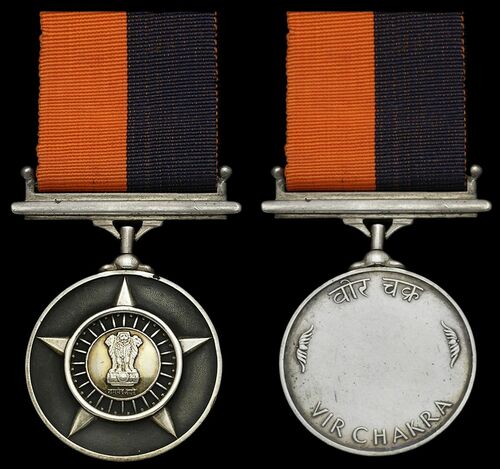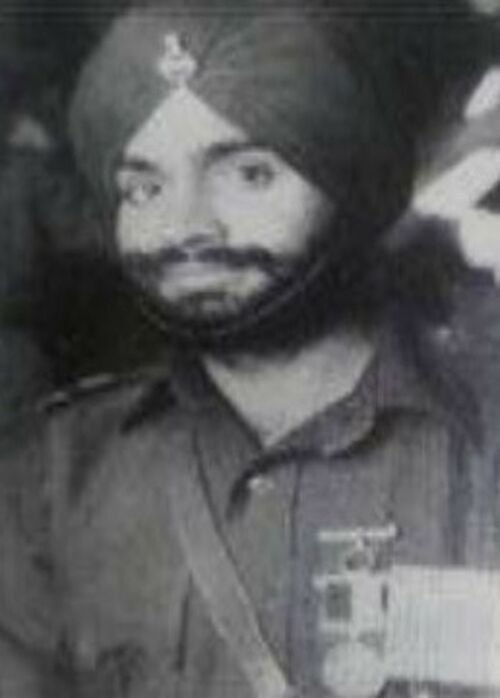Auction: 23112 - Orders, Decorations and Medals - e-Auction
Lot: 1011
The Vir Chakra Medal awarded to Subedar A. Singh, 4th Sikh Regiment, for his outstanding bravery on 10 September 1965 during Operation Riddle, when he led the advance to destroy an enemy bunker; although wounded he continued to crawl to the enemy's position, his Platoon was so inspired by his bravery they rushed and destroyed the enemy post
India, Republic, Vir Chakra (3339173 Hav.Ajmer Sigh, 4 Sikh. - 10 Sept. 1965), good very fine
Provenance:
DNW, March 1997.
Brian Russell Collection.
Vir Chakra Gazette of India 1 January 1966:
'On 10 September 1965, during the assault on Burki village in Pakistan, Naib Subedar (then Havildar) Ajmer Singh found his platoon pinned down by the rapid medium machine gun fire of the enemy. With great presence of mind, he crawled towards the enemy bunker and although hit by a burst he continued to advance. Inspired by his personal example his platoon rushed forward and destroyed the enemy position completely.
The leadership and courage displayed by Naib Subedar Ajmer Singh in this action were in the best traditions of the Indian Army.'
The Vir Chakra is an Indian gallantry award presented for acts of bravery in the battlefield. The award of the decoration carries with it the right to use Vr.C. as a postnominal abbreviation. It is third in precedence in the wartime gallantry awards and comes after the Param Vir Chakra and Maha Vir Chakra.
Ajmer Singh, a native of Ambala, Haryana, India was born on the 5 December 1935. He enlisted in the 4th Sikhs on the 5 December 1950 and took part in the Indo-Pakistan War of 1965 - specifically Operation Riddle, where he won his award during the advance on the village of Burki in Pakistan.
The Battle of Burki (Barki) was a battle fought by Indian Infantry and Pakistani Armour in the Indo-Pakistani War of 1965. Barki is a village that lies south-east of Lahore near the border with the Punjab, and is just 11km from the Allama Iqbal International Airport in Lahore.
During the fighting, the relative strengths of both sides were fairly even and Indian infantry clashed with Pakistani forces that were entrenched in pillboxes, dug-outs and slit trenches that had been carved into the canal banks. The Pakistanis were supported by a large number of tanks, as well as fighter jets. Nevertheless, the battle resulted in an Indian victory.
During the fighting the 4th Sikhs suffered 123 casualties, of which 23 were killed. The Sikhs won one MVC (Sub. Ajit Singh (posthumous.)), three Vr.C's ( L/Naik Pritam Singh (posthumous.), Maj. Shamsher Singh Manhas, & Hav. Ajmer Singh) and the battle honour 'Burki'.
The Battalion was then chosen to recapture Khem Karan. On 12 September, 200 men under Lieutenant-Colonel Anant Singh were selected for the attack. They marched through the night and reached the outskirts of Khem Karan, where a group of tanks were to link up with the men: the men rested for some time and then heard tank noises, thinking it was the Indian Armour they rushed out into a group of Patton tanks of the Pakistan Army.
During the fighting (in which 40 men were killed and another 40 men managed to break out) the rest including the C.O. were taken prisoner by the Pakistan Army.
Near the Enquiry Office, at Amabla Cantonment Railway station, there are two marble stones fixed on the wall in honour of two war heroes, Second Lt Ravinder Singh Bedi and Naib Subedar Ajmer Singh, both residents of Ambala - it stands there to this day.
Subject to 20% VAT on Buyer’s Premium. For more information please view Terms and Conditions for Buyers.
Sold for
£1,300
Starting price
£320







